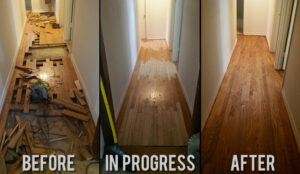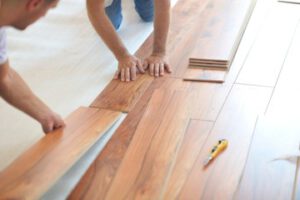Home » Posts tagged 'painting services'
Tag Archives: painting services
Steps in Floor Refinishing
If your hardwood floors have been worn down, you may want to consider Floor refinishing. It can be less expensive than replacing them and is less invasive to your home.

To determine whether a floor refinishing is right for your home, start with an honest assessment of the damage. It’s best to get a free consultation from an expert.
Sanding is an essential step in any hardwood floor refinishing project. It can help remove light scratches and stains, and it can even give the wood a new look. It can also help prepare a wood floor for staining or applying a protective coating of paint, lacquer or polyurethane.
There are many different types of abrasives to choose from when sanding. Some of the most common include silicon carbide, abrasive paper, abrasive cloth and ceramic. Regardless of what type of abrasive you use, it’s important to understand the differences between each.
Abrasives come in various sizes, shapes and grits. These vary in hardness, and each grit has its own characteristics, such as whether it’s coarse or fine.
The most important thing to remember when sanding is to keep the abrasive in contact with the floor. This ensures that the abrasive isn’t scratching the floor or causing damage to the finish.
If you’re using a drum sander, wear safety goggles, ear protection and a dust mask while operating the sander. Work the sander in long overlapping strokes, moving parallel to the direction of the boards, not across the wood grain.
To reduce the amount of wood dust produced, switch sandpaper frequently. It’s also important to sand in well-ventilated areas.
It’s a good idea to sand the floor in stages, starting with coarse paper and working your way up to finer grits. This way, you’re not cutting the wood too much or causing more harm than necessary.
Depending on the condition of the floor, you may need to stand more than once before it is completely smooth. Generally, hardwood floors can accept up to three deep sandings before they’re ruined.
If you’re sanding an older or very hard floor, it’s best to start with 36-grit sandpaper, rather than the coarser 24 or 16 grits used for a fresh, new floor. This can be especially true if the floor hasn’t been sanded in some time or has a heavy coating of paint or other finish on it.
Staining is a step in floor refinishing that involves applying a color-changing chemical to the wood. It can enhance the wood’s natural grain or create a new pattern. It also protects the wood from wear and tear.
There are many different types of stains, ranging from very light to dark and from water-based to oil-based. The type of stain you choose depends on the purpose of your project. For instance, a woodworker might prefer an alcohol-based stain for its ease of application and its ability to penetrate deep into the wood fibers.
Oil-based stains tend to result in more richly colored finishes than water-based stains, and they’re ideal for hard woods such as oak. However, they’re toxic and need decent ventilation. They can be applied with a brush, but use mineral spirits to clean the brush before you start applying the stain.
Whether you apply the stain with a brush or a rag, try to apply enough of it to cover the entire surface of the wood. This will minimize overlap marks that will make the finish look uneven and patchy.
If you’re staining a hardwood floor, consider choosing an alcohol- or spirit-based stain, which dry faster than traditional water-based stains. These stains are easier to apply with a brush and are ideal for wood with thick grain.
It’s a good idea to test the stain on scrap wood, so you can get the right shade. Then, follow the manufacturer’s directions for how much to apply and where to apply it.
When you’re finished, leave it to dry for 24 hours. Then, apply a protective coating called a clear finish. A coat of this will give your floors a polished, lustrous sheen and help them stand up to daily wear.
What You Need to Do Before Flooring Installation
If you’re considering installing new flooring in your home, you may be wondering what you need to do before getting started. Read on Vinyl Plank Flooring Installation to learn more.

When you decide to get new flooring in your home, there are some things you need to do first. These preparations will help ensure your installation goes smoothly.
One of the most important things to do is clear out the area before installation. This will help minimize cleanup and avoid accidental scratches.
You will need to remove furniture from the room. Depending on the type of flooring you choose, you may need to clear out shelves, closets, and other areas.
Before installing a new floor, you need to declutter the area and make sure there is enough room for the installers. Also, you need to make sure your pets and children are safe. Some installers will move heavy furniture and appliances for you. They will also make sure your electronics are properly disconnected.
Before the work begins, you need to remove any glass, ceramic, or glass-topped lighting fixtures. The same goes for any wall hangings or other decorations. Ideally, you will be moving these items into another room.
Then, you will need to make arrangements for any gas and electrical appliances. Gas-powered appliances need to be removed before installation. In addition, you need to provide access for the company to run the electric outlets. If you do not have these in place, you may need to arrange for professionals to do it for you.
After the flooring is installed, you can start painting. However, before you paint, you should check with the flooring specialist about the best methods for cleaning the surface. Many people opt for hardwood flooring because it does not hold dust.
You may need to make a few minor adjustments to your doors. Be sure to use hinges, not screws, when replacing them.
Getting a quote for flooring installation is important, especially if you’re planning to renovate or remodel your home. Having new floors installed can boost your home’s value and add to its appeal. You also need to consider the type of floor you’re going to install.
There are many different types of flooring and materials to choose from. Some of them are more expensive than others, but you can save money by shopping around. For example, you can opt for a slightly less expensive material and still get what you need.
A quote for a project like this can vary depending on the size of your house, your flooring type, your location, and the type of contractor you hire. A professional installer should be able to provide a price estimate for you.
If you’re ready to start a flooring project, you can either email or call a company. Many flooring companies offer free estimates. However, you may need to pay for travel costs or furniture moving fees.
The average cost of installing flooring is $3,067 for 500 square feet. Labor costs are typically the second largest factor in determining the cost of a job.
While the cost of a single flooring installation may seem high, the total cost of the entire project will depend on the size of your home, the type of floor you’re installing, and whether you’re removing an existing floor.
To get an accurate flooring installation quote, you should also inquire about any additional services the contractor might offer. For example, you might need to remove existing floors, or you might need to replace subfloors.
Another thing to keep in mind is the quality of the material. High-end materials can drive up the cost of a flooring project, but you can choose lower-cost materials if you want to save.
How to Choose the Right Hardwood Flooring for Your Home
When it comes to the purchase of hardwood flooring, you’re not the only one who has a lot of choices. There are different types of wood, cuts, colors, and species. The options are endless, and the choices you make will affect your home’s overall style. It’s also important to consider the cost of the material, as well as the resale value of the final product.

Prefinished vs. unfinished hardwood floors are two types of flooring that can be installed in your home. Each type has its own advantages and disadvantages. However, it’s important to make the right choice for your needs. You may want to talk to experts for more information about your options.
Prefinished hardwood flooring is a more durable alternative to unfinished floors. Since it’s finished before it’s shipped on-site, it’s less prone to water damage. It’s also easier to install and comes with a longer warranty. It’s more resistant to dents, scratches, and discoloration.
On the other hand, unfinished hardwood allows for a wide range of customizations. You can choose from many different species of wood and even paint it with unique effects. You can create a look that matches your personality and style.
When choosing between prefinished and unfinished floors, you should also consider how long you’ll need them. Prefinished floors can last for several years, but they may need to be refinished in the future. On the other hand, unfinished floors can be repaired and replaced individually.
Both types of flooring are great options for remodeling projects. Whether you’re restoring a classic floor or designing a new room, a professional can help you decide what’s best for your needs.
In addition, both types of flooring offer a variety of options when it comes to installation. Typically, you’ll need a power floor nailer or pneumatic stapler. You’ll also need a sander for an unfinished floor. This will help you get the evenness you need to ensure that your new flooring looks great.
Both kinds of flooring are popular choices for homeowners, so it’s important to weigh your options carefully. You’ll also need to consider your budget.
Wood flooring grade is an important factor to understand when buying hardwood. There are many types of grades available, each with its own characteristics. Choosing the right grade can help you achieve the look and feel that you’re looking for.
The National Hardwood Lumber Association (NHLA) sets industry standards for grading hardwood lumber. They have established eight individual grades for common domestic species, as well as exotic species.
In general, the higher the wood grade, the cleaner it looks. However, lower grades can be more expensive. These grades are often less dense and have more sapwood and holes. You’ll need to consider your financial situation and budget when determining your wood flooring grade.
The two most popular domestic species are White Ash and Beech. Both grades are durable and can be used for a wide range of purposes.
The #2 Common grade is a good choice for those seeking a rustic appearance. It’s also a good choice for general utility use. This grade has more boards that have natural wood marks, as well as large knots and bold streaks.
Another popular grade is Select. This grade has a smaller number of small knots and holes. The color can be a little bit different than the other grades. The wood is also slightly less uniform than the other grades.
Prime grade is the highest quality hardwood floor. It’s also the most expensive. It’s the best for general utility. It’s usually smooth and free of defects.
The next highest grade is Select. It’s only a slightly lower grade than the prime grade. It’s also the most uniform. The wood has a few imperfections, such as holes and cracks, and a few minor color variations.
Hardwood flooring is an excellent addition to any home, but it does have a price. Whether you’re installing it yourself or having it professionally installed, the cost will depend on your budget and the type of wood you choose.